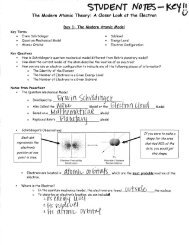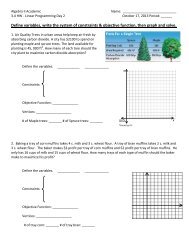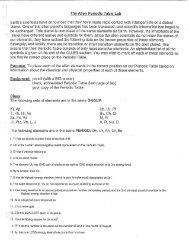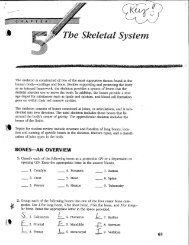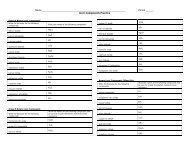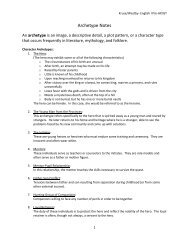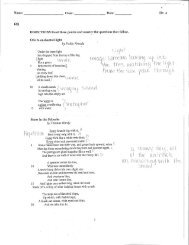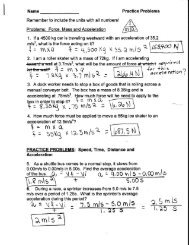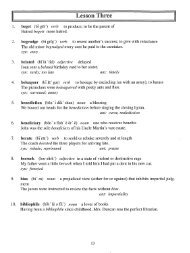Class notes
Class notes
Class notes
You also want an ePaper? Increase the reach of your titles
YUMPU automatically turns print PDFs into web optimized ePapers that Google loves.
9<br />
%ct,ss: q,z×ÿO-ÿxÿOO = 3,ÿoxÿo;<br />
O,?AO b-ÿ<br />
Applications of Aqueous Equilibria<br />
I. Common Ion Effect<br />
A. Objectives:<br />
1. Perform calculations on acidic solutions involving a common ion.<br />
B. The addition of a "common ion" to a solution can 5ÿ#A0f'ÿ the dissociation<br />
ofanacid. This based on ÿ ÿigdÿ5--ÿ principle.<br />
C. Consider acetic acid:<br />
HC2H302 (aq) ÿ-"-) a+ (aq) + C2H302 (aq)<br />
1. Add sodium acetate, }4 &ÿ-Z. ÿ A 0 ÿ. , which completely dissociates to<br />
form ÿ#L ffÿ and ÿ.ÿ0ÿ0 ÿ . The acetate ion is common to the<br />
solution. It is called the COMMON ION.<br />
2. The common ion imposes a Sntr!gg$ on the system.<br />
3. The system responds by shifting __] eÿ+ therefore, there is much<br />
, less dissociation than before.<br />
4. The general effect of a common ion is to depress the<br />
D. Because dissociation is depressed, we can assume that the equilibrium<br />
concentration of acetic acid equals the ]lfi/ÿ0kÿ ÿÿ 0ÿ . The<br />
same is true of the acetate ion.<br />
E. Example: Common ion effect<br />
1. Calculate the pH and the percent dissociation of the acid in each of the<br />
following situations:<br />
a. 0.200 M HCzH302 (Ka = 1.8 X 10-5)<br />
b. 0.200 M HCaH302 in the presence of 0.500 M NaC2H302<br />
2. Solutions:<br />
Iÿ+( )tCz.%o:2 ( )<br />
a.. % _ "q<br />
Cÿ4 e7.ÿ%o.ÿ3<br />
7-= ITS+3 =[ezP,ÿoZ3 : I"ff':al°-sN , pie: z,7<br />
o!o &ssodoÿ4noÿ =- l,q × 10-3 X t00% : ooqS%<br />
[ ÿt4ÿoÿyJ : o,zoom<br />
: 0,5oo Ui<br />
!,9× ÿo-ÿ: ÿH+3f o,s-oo1<br />
D,ZOO
©<br />
Buffered Solutions // ¢tA'ÿCÿ "I+S 5,'4"@- ÿ)
go+,t h0,4 wgll<br />
i ;<br />
. j<br />
D.<br />
1.<br />
Example: pH Changes in buffered solutions<br />
Calculate the change in pH that occurs when 0.010 mol solid NaOH is<br />
added to 1.0L of the buffered solution in example C-1 above. Compare<br />
this pH change with that which occurs when 0.010mol solid NaOH is .... o<br />
added to 1.0L of water.<br />
2. Solution:<br />
V' ,5'<br />
' -3<br />
iÿ6,< I0<br />
k L ' '!<br />
\<br />
,, '-.\<br />
beÿ4_ÿarce<br />
loÿs 1+1<br />
€ ,OL)'-O,50ÿ O,OÿOÿ° i ÿOLx O,SOÿ --*<br />
= o,s-oÿo I ÿ _- 0°b-owd<br />
0,ÿ50- 0,010 Omo/ 0ÿ$o+ 6,010a<br />
3.<br />
¢<br />
g,<br />
ezl4ÿOÿ ÿ ÿ4+ +<br />
o.ÿtq, o<br />
,qq-ÿ x<br />
e %o/<br />
O,S'ÿ<br />
+X<br />
,Sl+X<br />
I,ÿX tO-S" =_<br />
oÿ- 40 44ÿm baÿa4 sotÿn<br />
,q(o- ÿ,qV -- + o,os
®<br />
g.<br />
Calculation of buffered solution and introduction of<br />
Henderson/Hasselbalch equation.<br />
1. Calculate the pH of a solution containing 0.75 M lactic acid (gO =<br />
1.4 X 10-4 ) and 0.25 M sodium lactate. Lactic acid (HCgH503) is a<br />
common constituent of biological systems. It is present in milk and<br />
human muscle tissue during exercise.<br />
2. Solution:<br />
eÿt4goÿÿ" oM ÿ.o<br />
I: ,qÿ o<br />
E: ÿlS-'g X<br />
4×<br />
,ÿ+X<br />
['xlg zÿ¢xa {xJ(,zs)<br />
° oTN ÿY ,7bÿ<br />
q-°Z:ÿ Io-¢ )ÿ<br />
f, er: fÿKo. +<br />
I<br />
1,ÿ'¢ ÿd¢ =. 3,{35)
F. Another buffer solution example: -ÿ<br />
1. A buffered solution contains 0.25 M NH3 (Kb = 1.8 X 105) and<br />
0.40 M NI-I4C1. Calculate the pH of this solution.<br />
2. Solution:<br />
+Lc)<br />
- o,qo o<br />
+x 4-X<br />
! ,% g tO"¢ÿ Ap, o+x3<br />
O,'Zg- X<br />
y<br />
6bÿ<br />
G. Adding strong acids and bases to buffers<br />
1. Real utility of buffers comes when we add a strong acid or base.<br />
2. Buffered solutions should 1Pÿ5ÿ$ÿ pH change when a substantial<br />
amount of ÿ:t"@ or 0 ÿ ÿ ions are added. (Substantial amount<br />
will be discussed later- will vary from solution to solution based on<br />
"buffer capacity."<br />
3. If we add a strong base to a solution that contains a weak acid, the<br />
reaction is C.I)¢ÿ#ÿ]'ÿ.:..<br />
HA(aq) + OH (aq) :-> A (aq) + H20 (1)<br />
. Similarly, adding a strong acid to a weak base gives a complete<br />
reaction:<br />
A- (aq) + H+(aq) ÷ HA(aq)<br />
. Notice that in these equations, unless ÿJlÿ%5 strong acid or base<br />
is added, NO STRONG ACID OR BASE BUILDS UP. Only o<br />
=llCÿ species remain. This is why a buffer works so ÿ!,ÿ<br />
H. Example: Addition of a strong acid to a buffer<br />
OÿF ÿ<br />
1. Calculate the pH of the solution that results when 0.10 mole gaseous<br />
HC1 is added to 1.0L of the buffered solution from the example in II F. 4ÿ prÿ¢0n5<br />
1ÿ!tÿ ÿ 1ÿtÿÿ: , e.ÿ btÿ: aÿ± ÿ4ÿo<br />
4o4" +<br />
bÿ:( I,0c)l 0.ÿN)<br />
= 0,ÿ.$'ÿo\<br />
vÿiH rÿ+'. .<br />
lqÿÿ = O,qOÿol<br />
0 O,q-O+ 0°i0<br />
= 0,ÿ"0¢ÿol
III.<br />
Buffer Capacity<br />
A. Objectives:<br />
1. Calculate the pH of a solution where the buffer capacity has been<br />
exceeded.<br />
2. Choose among alternatives for the best buffer system for a given pH. n ÿ ÿ ,ÿ<br />
Q<br />
2V_a t+ÿl fÿ f4<br />
pH:<br />
B. Two important points: z ÿ===ÿ-'--- ÿ C,/ÿ .- ÿ kÿJ ]<br />
1. The pH is determined by the ratio oÿ,[HA]/[A- ] 2ÿ ÿ[-ÿÿ !/k,ÿ r ÿ ÿ,Aÿ'<br />
2. The buffer capacity is detennined by t'h-ÿnSaÿnltuÿ des of [I-IA] and [A-]. ÿZÿ<br />
The more you have, the more strong acid or strong base that can be 0<br />
neutralized.<br />
C. Example: Adding a strong acid to a buffered solution<br />
1. Calculate the change in pH that occurs when 0.010 mole gaseous HC1<br />
is added to 1.0L of each of the following solutions: ÿÿ dkÿl'ÿ<br />
Solution A: 5.00 M HC2H302 and 5.00 M NaC2H302 I, ÿ N t ;- ÿ<br />
Solution B: 0.050 M HC2H302 and 0.050 M NaC2H302<br />
2. Solution:<br />
# ÿ + io9 ( rÿ h zn ÿaÿ, cÿ, Lo aÿ3czJ=<br />
£r4 g.zÿ430ÿ-ÿJ . , crNCx1430zÿ<br />
: - Ioq ÿ¢, ÿ ×/0-s') :<br />
-ÿ eÿ43 oÿ_ eÿ) eoÿplÿbÿ<br />
if, Oopl<br />
5ÿ,OIM<br />
4b,- son ÿ ÿÿ<br />
vSoOÿ /" , 0017=<br />
q, vg
4- HCÿ ÿ4a; 0ÿ_<br />
®<br />
o, 0£oÿ<br />
0, oÿoN<br />
qnÿ+ lo5 lo,°ÿ° )<br />
\ O.¢too<br />
o , OSo H<br />
o , o (ÿ o ?q<br />
o<br />
or<br />
,%'<br />
"D. The example above compares the pH change brought about by adding a<br />
strong acid to solutions with different buffering capacities. Let's try a<br />
problem where we exceed the buffering cÿpacity of a solution.<br />
1. Example: Calculate the pH ofa 0.50(!ÿolution that contains 0.15 M<br />
HCOOH (Ka = 1.8 X 10-4) and 0.20 M HCOONa. Then calculate the<br />
pH of the solution after the addition of 10.0(ÿ of 12.0 M NaOH.<br />
HeÿoH(=!ÿ Hÿ ÿaI3 + ÿoo- c@<br />
\\ ,ÿ.G ÿ[' ÿ?ÿ.ÿ'ÿ' '<br />
/' "ÿ" r '- , , C)<br />
.ÿ - t ,o ' ,,[; , y ÿr 32\<br />
- LHq-3EOcoo-3 : ÿ,ll×I0-q = C A*% o,ÿ.o"<br />
g hÿco o ÿ3<br />
gHtÿ = ! q-×¢o"qN J<br />
¢eooC-¢ ,%..0 (.0<br />
L.¢.. ÿ mmoles<br />
lq IooH [nhhM =<br />
ffeAgO o =<br />
. .---oÿLa.qgmmol<br />
O, 15mmoÿmL g,,,bo ,. o<br />
/ 0o mmo m L % 10-o ÿL = IZo °
U)<br />
g. Preparing a Buffer<br />
1. pH of a buffered solution depends on the ratio of the concentrations.._.,..........,,._ÿof<br />
the buffering components<br />
a. table:<br />
b. Becauseÿchanges in the ratio [A-]/[HA] will produce large<br />
changes in pH, we want to avoid this situation for the most<br />
effective buffering>> so optimal buffering occurs when [HA]<br />
=[A].<br />
c. When choosing the buffering components for a specified<br />
application, we want [A']/[HA] to equal 1ÿ<br />
d. It follows the pKa of the weak acid to used in the buffer should be<br />
as close as possible to the desired pH.<br />
e. If you desire a buffer with a pH of 4, choose a weak acid with a<br />
pKa of 4, or a Ka of 1.0 X 10-4.<br />
2. Example: A chemist needs a solution buffered at pH 4.30 and can<br />
choose from the following acids and their sodium salts:<br />
a. Chloroacetic acid (Ka = 1.35 X 10-3)<br />
b. Propanoic acid (Ka = 1.3 X 10-5)<br />
c. Benzoic acid (Ka = 6.4 X 104)<br />
d. Hypochlorous acid (Ka = 3.5 X 10-8)<br />
Calculate the ratio [HA]/[A] required for each system to yield a pH of<br />
4.30. Which system will work best? ÿal ÿ.<br />
Eÿ-3 ° , ÿ0 eJoSeST<br />
O ,V-g<br />
I, ,?x ioÿ<br />
laaÿ.r.oÿc ÿ.,u ,-, ° 5 ÿ ha.o & ÿ add
o_oÿ<br />
@<br />
IV. Titrations and pH Curves<br />
A. Objectives:<br />
1. You should be able to calculate the pH at any point along a curve for the<br />
following titrations:<br />
a. Strong acid-strong base<br />
b. Weak acid-ÿe,ÿaWÿ ÿ0¢a$©<br />
c. Weak base-strong acid<br />
2. You should be able to define the terms:<br />
Titranta.<br />
b. Buretc.<br />
Indicator<br />
d. Titration curve-=<br />
, , nÿcÿ Oxz.wJ<br />
e. Equivalence point- 5%1 ¢Jÿt oÿ,,ÿLÿr,c ÿe I I .<br />
f. Endpoint-ÿhÿ*wÿe-ÿ4-ocÿCktÿvtÿ Oÿt<br />
3. In order for a titration to be feasible, it must be complete and fast. In order to<br />
be complete, the reaction should have a value ofK > 107 or so.<br />
B. Review Neutralization Reactions<br />
. Example: Neutralization reactions I<br />
a. What volume of 0.100 M HC1 solution is needed to neutralize 25.0 mL of<br />
0.350 M NaOH?<br />
b. Solution: ÿ C.15 ÿdÿt, 0ÿ<br />
Z)ÿ01ÿ+ cxn will oÿxF? Nÿ4-4c1ÿ ÿ NaCl(.s)-ÿSo[ÿI¢ÿgÿ4ÿsJ go rxv<br />
4-) eaÿIe.Mÿ raoles rÿcÿn4g.<br />
cÿoa<br />
ÿ.vxx roÿ-3 mol R÷asÿi
@<br />
. Example: Neutralization Reactions II<br />
a. In a certain experiment, 28.0 mL of 0.250 M HNO3 and 53.0 mL of 0.320<br />
M KOH are mixed. Calculate the amount of water formed in the resulting<br />
reaction. What is the concentration of I-1+ and OH- ions in excess after the<br />
reaction goes to completion?<br />
- t_/4u0<br />
§5,oraL Kot-ll It... 01t'=<br />
L Ko 4<br />
. Example: Neutralization Reactions III<br />
a. Problem: A student carries out an experiment to standardize (determine<br />
the exact concentration of) a sodium hydroxide solution. To do this, the<br />
student weighs out a 1.3009g sample of potassium hydrogen phthalate<br />
(KHC8H404, often abbreviated KHP; molar mass 204.22 g/mol) KHP has<br />
one acidic hydrogen. The student dissolves the KHP in distilled water,<br />
adds phenolphthalein as an indicator, and titrates the resulting solution<br />
with the sodium hydroxide solution to the phenolphthalein endpoint. The<br />
difference between the final and initial buret readings indicates that 41.20<br />
ml of the sodium hydroxide solution is required to react exactly with the<br />
1.3009g KHP. Calculate the concentration of the sodium hydroxide<br />
solution.
H opt N oH =<br />
L<br />
C. Strong Acid-Strong Base Titrations<br />
. Will use a new unit which is more convenient for titrations<br />
a. Burets are typically in mL<br />
b. Titrations involve small quantities<br />
c. Mole is inconveniently large.<br />
d. Will use millimole (mmol) which is a thousandths of a mole:<br />
IO00<br />
e. Will look at molarity as: ÿ,ÿ= p¢ÿOlÿ Solctÿ<br />
. Strong Acid-Strong Base Titration- Step by step.<br />
a. We will illustrate the calculations involved in a strong acid-strong base<br />
titration by considering the titration of 50.0 mL of 0.200M HNOs with<br />
0.100 M NaOH. We will calculate the pH of the solution at selected points<br />
during the course of the titration, where specific volumes of 0. ! 00 M<br />
NaOH have been added.<br />
Graph of progress:
@<br />
Point A: No NaOH has been added. 0<br />
14ÿ4o3 ÿmptÿ+ÿtÿ &ÿocio.ÿ SCer4'ÿ:<br />
pH ÿeÿcÿlnÿd ÿom H+ ,<br />
lncÿ 0,Z0OM HNOg eorrgams O,zooÿ<br />
gt4+3 = O, aoo M, PN = 0,6q9<br />
Point B: 10.0 mL of 0.100 M NaOH has been added.<br />
.. H+ 4 OH- --ÿ Hÿo<br />
rWl. ÿ-Omlÿ.ÿZM Io,OmlX ,IH .<br />
= IO,Ommol = l, oommol<br />
rrm /Oÿl = ÿ retools 1,0o-/.oo=<br />
o (nÿo le3<br />
VolOmÿ ÿ - (SN,OelO,O)mc<br />
,ÿ. ÿ0ÿ ÿ" vol, ÿoÿ4 Mdÿd<br />
Point C: 20.0 mL (total) of 0.100 M NaOH has been added.__<br />
H÷ + off - -ÿ Hÿ.o<br />
=lOmrno]<br />
=ÿmcÿo[s<br />
(ÿo, o ÷ao, owc)<br />
Point D: 50.0 mL (total) of 0.100MNaOH has been added.ÿ ÿY*ÿ(ÿ ÿ #ÿOV'ÿ 3 fÿ - I ÿ-ÿ-<br />
Point E: 100.0 mL (total) of0.100M NaOH has been aÿ.0<br />
IOOmL x O, loom= lo, ommÿIs<br />
0rÿtngl ÿvmÿc ÿ05 cOÿ; EOoOmL "aO, ZOO¢¢l- ;Ommo/5
®<br />
f.ÿ,k[oHÿj= JXro<br />
3. Strong base with strong acid will produce this type of graph.<br />
D°<br />
gO ,00, t<br />
Titrations of Weak acids with strong bases.<br />
1. Strong acids/bases completely dissociate, so calculations are straightforward.<br />
2. When weak acid is being titrated, to calculate ItS] after a certain amount of<br />
strong base has been added, we must deal with the weak acid dissociation<br />
equilibrium.<br />
3. Really a series of buffer problems.<br />
4. Remember that even though the acid is weak, it reacts essentially to<br />
completion with hydroxide ion, a very strong base.<br />
5. Calculating the pH curve for a weak acid is a two step procedure:<br />
a. A stoichiometry problem<br />
b. An equilibrium problem<br />
c. Do these steps separately! You already know how to do them.<br />
6. Example: Weak acid- Strong base titration<br />
a. Consider the titration of 50.0 mL of 0.10 ÿ acetic acid (HC2H3 02, Ka=<br />
1.58 X 104) with 0.10 M NaOH.
Graph of Progess:<br />
Point A: No NaOH has been added.<br />
Point B: 10.0 mL of 0.10 MNaOH has been added.<br />
bÿ ÿfÿdÿ4: {+cÿHsoÿ, oH7 t4ÿ,% nÿo<br />
OH- ÿ<br />
HgzHÿOÿ<br />
+x<br />
: #. o/eo = x ×<br />
= i,S-x ÿo<br />
__ =<br />
=ÿZs'X<br />
Point C: 25.0 mL (total) of 0.10 M NaOH has been added.<br />
OH- + BetH,0z<br />
%,OÿL'x,/M<br />
.o5= g,5-ÿ 0
÷Y<br />
[Hca Hÿ 0ÿ3 a,::ÿ _ )
Point C: 25.0 mL (total) of 0.10 M NaOH has been added.<br />
Point D: 40.0 mL (total) of 0.10M NaOH has been added.<br />
Point E: 50.0 mL (total) of 0.10M NaOH has been added.<br />
to=- 5, (0X" t 0ÿ1°<br />
Z O, o5o ÿ o 0<br />
---- ÷ÿ +Y<br />
C" -X<br />
C'. o, oÿo-7:<br />
.ÿ y. f<br />
5,L+y.IO-ÿo V._b ÿ- gHCÿ1430-z]£°H-3- (XÿX)<br />
O, 05-o<br />
[ÿ÷3Co ÿ-2 : i.o ÿ \o-'ÿ
Point F: ÿ'- ÿ.<br />
oH- -ÿ Hcÿ_Hsoÿ. CÿHsOÿ- gÿo<br />
Soÿo,ÿk x, I h-I<br />
=. %0 ,'r, mo I<br />
5
Point G:<br />
7. Compare two graphs<br />
a. Shapes axe quite different before equivalence point although very similar<br />
after that point (because excess OH" controls the pH in the later region in<br />
both cases.)<br />
b. Near the beginning of the titration of the weak acid, the pH increases more<br />
rapidly that it does in the strong acid. It levels off near the halfway point<br />
and then increases rapidly again. The leveling offnear the halfway point is<br />
caused by buffering effects. Optimal buffering occurs when [HA] = [A- ].<br />
This is exactly the case at the halfway point of the titration, pH changes<br />
least rapidly in this region of titration.<br />
c. For the titration of a strong acid, the equivalence point occurs at pH "7<br />
d. For the titration of a weak acid, the pH at the equivalence point is<br />
than 7 because of the basicity of the conjugate base of the weak acid.<br />
e. Remember, the equivalence point in an acid-base titration is defined by the<br />
5ÿK4.(ÿÿCÿ, not by the ÿ.<br />
E. Titrations of Weak Bases with Strong Acids<br />
1. Problem: 100.0 mL of 0.050 M NH3 is titrated with 0.10 M HC1.<br />
Graph and Results:<br />
Before the addition of any HCI:<br />
1. Major species: ÿJ ÿ and ÿ._O<br />
NH3 is a base and will seek a source of protons. In this case, water is the only<br />
available source.<br />
2. No reactions occur that go to completion since NH3 cannot readily take protons<br />
from water. This is evidenced by the small Kb value for NH3.
. The equilibrium that controls the pH involves the reactions of ammonia with<br />
water:<br />
Use Kb to calculate [OH-]. Although NH3 is a eak base (compared with OH-), it produces<br />
much more OH- in this reaction than is produced from the autoionization of water.<br />
Before the equivalence point:<br />
1. Major species (before any reaction occurs):<br />
Rt O__ t- kilo<br />
2. The NH3 will react with I-I+ from the added HCI:<br />
This reaction proceeds essentially to completion because the NH3 readily reacts with a<br />
free proton. This case is much different than the previous case, where water was the only<br />
source of protons. The stoichiometric calculations are then carried out using the known<br />
volume of 0.10 M HC1 added.<br />
° After the reaction of NH3 with H÷ is run to completion, the solution contains the<br />
following major species: uz -C-o,ÿ ÿn 4-dnca.'kÿvÿ<br />
, , t4.. o<br />
Note that the solution contains NH3 and NH4 +, and the equilibria involving these species<br />
will determine [H+]. You can use either the dissociation reaction ofNI-I4+<br />
Or the reaction of NH3 with water:<br />
At the equivalence point:<br />
. By definition, the equivalence point occurs when all the original NH3 is converted<br />
to NH4+. Thus the major species in solution are:<br />
.<br />
3.<br />
No reactions go to completion.<br />
The dominant equilibrium (the one that controls the [I-l+]) will be dissociation of<br />
the weak acid NH4+ for which
Beyond the equivalence point:<br />
1. Excess HC1 has been added, and the major species are:<br />
ff _.o<br />
) } I<br />
2. No reaction occÿs that goes to completion.<br />
3. Although NI-I4 + will dissociate, it is such a weak acid that [H+] will be<br />
determined simply the excess H+:<br />
4. The results of the calculation are shown below: 09. ÿ@(ÿ ÿ-ÿd.ÿ_ÿ / ÿ-,<br />
go Acid - Base Indicators<br />
A. Two common ways to determine the equivalence point of an acid-base<br />
titration:<br />
1. Use a pH meter.<br />
2. Use an acid-base indicator<br />
a. Marks the end point of titration by turning color<br />
b. Most are weak acids that exhibit one color when the Woton is<br />
attached to the molecule and another when the proton is absent.<br />
Ex. Phenolphthalein is pink in base and colorless in acid.j
1. Example: HC1 + NaOH could use BTB with a pH color change<br />
range of 6.2-7.6, but not methyl yellow which has a pH range<br />
of 2.9-4.0<br />
D. How much indicator should be used?<br />
1. Usually only a very small amount needed<br />
2. Are very weak acids and are not the dominant source of protons in an<br />
acid base reaction.<br />
E. Color chart of indicators is in textbook on pg.
VI. Solubility Equilibria<br />
A. Objectives: In this section, we consider equilibria associated with solids<br />
dissolving to form aqueous solutions, interconvert between solubility and<br />
Ksp, solve problems relating to the common ion effect.<br />
B. Solubility is an important phenomenon.<br />
1. Example: tooth decay involves solubility- When food is lodged<br />
between teeth, acids form containing hydroxapatite, Cas(PO4)3OH.<br />
If treated with fluoride, F replaces the OH- to produce fluorapatite,<br />
Ca5 (PO4)3F and CaC12. both of these are less soluble in acids than the<br />
original and thus deter tooth decay.<br />
C. How it works:<br />
1. Take for example, calcium fluoride dissolving in water.<br />
a. When the solid salt is first added to water, no calcium and fluorine<br />
ions are present. However, as dissolution proceeds, the<br />
concentrations of Ca+2 and F" increase, making it more and more<br />
likely that these ions will collide and re-form the solid- so two<br />
competing processes are occurring- the dissolution reaction and the<br />
reverse.<br />
b. Ultimately, dynamic equilibrium is reached:<br />
At this point, no more solid dissolves and the solution is said to be<br />
saturated. The equilibrium expression for this process according to<br />
law of mass action is written as:<br />
c. Ksp is called the solubility product constant or the solubility<br />
• product for the equilibrium expression.<br />
1. The amount of excess solid present does not affect the position<br />
of the solubility equilibrium<br />
a. When ions in solution reform the solid, they do so on the<br />
surface of the solid, so doubling the surface area of the<br />
solid not only doubles the rate of dissolving, but also<br />
doubles the rate of re-formation of the solid. The amount of<br />
excess solid present has no effect on the equilibrium<br />
position.<br />
b. Increasing the surface area by grinding up the solid or<br />
stirring the solution speeds up the attainment of<br />
equilibrium, but does not change the amount of solid<br />
dissolved at equilibrium. Neither the amount of excess<br />
solid nor the size of the particles present will shift the<br />
position of the solubility equilibrium.<br />
c. Remember, the solubility product is an equilibrium<br />
constant and has one ÿvalue for a given solid at a given
temperature. Solubility, on the other hand, is an equilibrium<br />
position. The Ksp expressions of many solids are listed in<br />
the table attached. Units are customarily omitted.
-ÿ- q--,.o x t o-ÿ<br />
D° Example: Calculating Ksp from solubility<br />
1. Copper (I) bromide has a measured solubility of 2.0 X 10-4 moliL at
.<br />
E. Example: Calculating solubility from Ksp<br />
The Ksp value for copper (II) iodate is 1.4 X 10-7 at 25°C. Calculate its solubility<br />
at 25°C.<br />
O 0 0<br />
L_.,<br />
"ÿkuz) /<br />
L<br />
F. Relative Solubilities<br />
1. A salt'sÿsp value gives us information about its solubility. However,<br />
we mum be careful in using Ksp values to predict the relative<br />
solubilities of a group of salts. There are two possible cases:<br />
a. The salts being compared produce the same number of ions:<br />
x /v
Each of these solids dissolves to oroduce two io1ÿ'.<br />
Ifx is the solubility of the salt in mol/L, then at equilibrium,<br />
Therefore, in this case we can compare the solubilities for these solids by comparing the<br />
Ksp values:<br />
t ÿ¢g-Sg b. The salts being compared produce different numbers of ions. For<br />
o<br />
example, consider: . ,<br />
8tzSCis) ÿs(p = g, $-x lO-qÿ<br />
Jtÿ St (s.) /
H. pH and solubility<br />
1. The pH of a solution can greatly affect a salt's solubility.<br />
2. Consider the dissolution of Magnesium hydroxide:<br />
a.<br />
b.<br />
C°<br />
d.<br />
Addition of OH- ion (an i P/Aa.stÿ n ÿ ÿ in pH) will, by the common ion<br />
effect, foÿtÿ'he equilibriumÿeasing the ÿof<br />
Mg(OH)2. ÿ o'<br />
On the other hand, if I-1+ ions (a Jÿjlÿ.dÿ3.xÿin pH ) are added, the solubility<br />
j_]_ÿÿ because OH ions are removed from solution by reacting<br />
with the H+ ions. In response to the lower concentration of OH-, the equilibrium<br />
moves to the ÿ .<br />
This is why asusp£'tasion of solid milk of magnesia dissolves as required in the<br />
stomach to combat acidity.<br />
General Rule: If the anion X- is an effective base, that is ifHX is a weak acid- the<br />
salt MX will show increased solubility in an acidic solution.<br />
1. Common ions that are effective bases are: OH-, S-2, CO32, C20412, and CrO4-2<br />
2. The above salts are much more soluble in acidic solution than in pure water.<br />
3. Is the reason for the formation of huge limestone caves- carbon dioxide in<br />
groundwater makes it acidic increasing the acidity of the calcium carbonate.<br />
As the carbon dioxide escapes to the air, the pH of the dripping water goes up<br />
and the calcium carbonate precipitates forming stalactites and stalagmkes.<br />
VII.<br />
Precipitation and Qualitative Analysis<br />
A. Let's consider the formation of a solid from solution.<br />
B. We will predict whether a precipitate will form when two solutions are<br />
mixed using the l 0 tQ /3g'oÿ oÿl=- which is defined just like<br />
Ksp except, that I ¢71'ÿ ÿ I concentrations are used instead of<br />
i#ÿt"l ÿ concentrations. For solid CaF2' the expression<br />
forCthe ion product is written:<br />
C. To predict whether precipitation will occur, we consider the relationship<br />
between Q and Ksp.<br />
1. If Q is greater than Ksp, precipitation OCpÿLO(-.$ and will<br />
continue until the concentrations are reduced to the point that they<br />
satisfy Ksp.<br />
2. If Q is less than Ksp, no precipitation occurs.<br />
D. Example:
1. A solution is prepared by adding 750.0 mL of 4.00 X 10-3 M Ce(NO3)3<br />
to 300.0 mL of 2.00 X 10.2 M KIO3. Will Ce(IO3)3 (Ksp = 1.9 X 10"1°)<br />
precipitate from this solution?<br />
rÿn ÿÿoÿ<br />
/it)ÿ<br />
, (-pS-o oÿc)_( ¢,o0/ 1o-3 mmo _<br />
o = (-Tgo.o +-ÿoo,o )too<br />
1 %-7o (3oo, o c) ( ooj<br />
g.<br />
Sometimes we want to do more than simply predict whether precipitation<br />
will occur; we may want to calculate the equilibrium concentrations in the<br />
solution after precipitation occurs.<br />
1. Calculate the equilibrium concentrations of Pb+2 and I- ions inÿ--/'ÿ3ÿ<br />
solution formed by mixing 100.0 mL of 0.0500 M Pb(NOg)ÿaÿ-'and 200.0 ÿ.ÿ<br />
2. Solution:<br />
SOO,O
1. Mixtures of metal ions in aqueous solution are often separated by<br />
5jÿ -ÿ j,qY(0- ÿ q-2 ff)ÿ ÿLfiÿ - ÿelective precipitate precipitation, with only that one is, or a by few using ofthe a reagent metal ions whose in the anion mixture. forms For a<br />
@(ÿ, 3"5g t0-z H- ÿ ×)SL example, suppose we have a solution containing both Ba+2and ag+'.<br />
"- X ÿ ÿ, 3 "5 )ÿ I oÿz)'2-- ions. If NaCI is added to the solution, AgC1 precipitates as a white<br />
[9b °z4ÿ ÿ X - iÿ ?:x ÿs- solid, but since BaC12 is soluble, the Ba+2 remains in solution.<br />
2. Example: A solution contains 1.0 X 10.4 M Cu+ and 2.0 X 10-3 M Pb+2.<br />
If a source of 1-is added gradually to this solution, will PbI2 (Ksp= ÿ I.<br />
3"b/t 0=<br />
x l0-8 ) or CuI (Ksp = 5.3 X 10-12) precipitate first? Specify the<br />
concentration of I- necessary to begin precipitation of each salt.
G. Qualitative Analysis (chart)<br />
VIII.<br />
Complex ion equilibria<br />
A. Complex ions are charged species consisting of a t4/ÿ<br />
surrounded by i ÿÿoÿ . A ligand is a Lewis bcÿoeÿ<br />
ion<br />
-a
molecule or ion having a lone electron pair that can be donated to an<br />
empty orbital on the metal ion to form a G0xt-0.ÿz4-,ÿ bond.<br />
g.<br />
C.<br />
Common ligands:<br />
Number of ligands attached to the metal ion is called the<br />
@_2xÿ . The most common coordination<br />
numbers are : ÿl ÿ t (o ..<br />
D° Metal ions add ligands one at a time in steps characterized by equilibrium<br />
constants called formation constants or stability constants.<br />
1. Consider when solutions ofAg÷ and NH3 molecules are mixed, the<br />
following reactions take place<br />
° Calculating the concentrations of all these components can be<br />
complicated, however usually the total concentration of the ligand is<br />
much larger than the total concentration of the metal ion, and<br />
approximations can greatly simplify problems.<br />
. Example:<br />
a. Consider a solution prepared by mixing 100.0 mL of 2.0 M NH3<br />
with 100.0 mL of 1.0 X 10-3 AgNO3. Before any reactions occurs,<br />
the mixed solution contains the major species:<br />
We know that the reaction that will occur is:<br />
However, we are interested in the reaction between NH3 and Ag+<br />
to form complex ions and since the position of the preceding<br />
equilibrium lies fax to the left (Kb for NH3 is 1.8 X 10-5), we can<br />
neglect the amount of NH3 used up in the reaction with water.
f,ÿlJ<br />
¢<br />
/,ÿÿ<br />
2, S4



